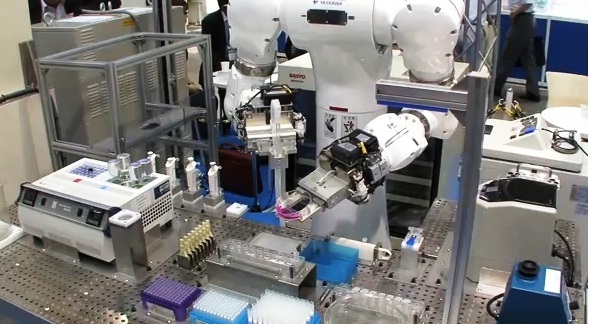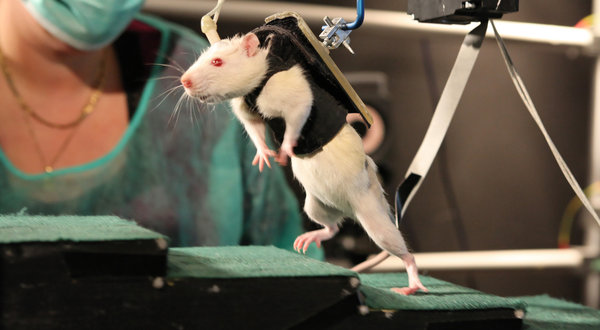Tuesday, September 11, 2012
Retinal Development
- Salbreux G, Barthel LK, Raymond PA, Lubensky DK. Coupling mechanical deformations and planar cell polarity to create regular patterns in the zebrafish retina. PLoS Comput Biol. 2012 Aug;8(8):e1002618. Epub 2012 Aug 23. PubMed PMID: 22936893; PubMed Central PMCID: PMC3426565.
- Chen M, Wang K, Lin B. Development and degeneration of cone bipolar cells are independent of cone photoreceptors in a mouse model of retinitis pigmentosa. PLoS One. 2012;7(8):e44036. Epub 2012 Aug 31. PubMed PMID: 22952865.
- He J, Zhang G, Almeida AD, Cayouette M, Simons BD, Harris WA. How variable clones build an invariant retina. Neuron. 2012 Sep 6;75(5):786-98. PubMed PMID: 22958820.
- Commentary: Chen Z, Li X, Desplan C. Deterministic or stochastic choices in retinal neuron specification. Neuron. 2012 Sep 6;75(5):739-42. PubMed PMID: 22958814.
Eye disease
- Murakami Y, Matsumoto H, Roh M, Suzuki J, Hisatomi T, Ikeda Y, Miller JW, Vavvas DG. Receptor interacting protein kinase mediates necrotic cone but not rod cell death in a mouse model of inherited degeneration. Proc Natl Acad Sci U S A. 2012 Sep 4;109(36):14598-603. Epub 2012 Aug 20. PubMed PMID: 22908283.
- Kohl S, Coppieters F, Meire F, Schaich S, Roosing S, Brennenstuhl C, Bolz S, van Genderen MM, Riemslag FC; the European Retinal Disease Consortium, Lukowski R, den Hollander AI, Cremers FP, De Baere E, Hoyng CB, Wissinger B. A Nonsense Mutation in PDE6H Causes Autosomal-Recessive Incomplete Achromatopsia. Am J Hum Genet. 2012 Sep 7;91(3):527-532. Epub 2012 Aug 16. PubMed PMID: 22901948.
- Manzini MC, Tambunan DE, Hill RS, Yu TW, Maynard TM, Heinzen EL, Shianna KV, Stevens CR, Partlow JN, Barry BJ, Rodriguez J, Gupta VA, Al-Qudah AK, Eyaid WM, Friedman JM, Salih MA, Clark R, Moroni I, Mora M, Beggs AH, Gabriel SB, Walsh CA. Exome Sequencing and Functional Validation in Zebrafish Identify GTDC2 Mutations as a Cause of Walker-Warburg Syndrome. Am J Hum Genet. 2012 Sep 7;91(3):541-7. PubMed PMID: 22958903.
Genetics
- Schmitt MW, Kennedy SR, Salk JJ, Fox EJ, Hiatt JB, Loeb LA. Detection of ultra-rare mutations by next-generation sequencing. Proc Natl Acad Sci U S A. 2012 Sep 4;109(36):14508-13. Epub 2012 Aug 1. PubMed PMID: 22853953.
- Papers related to ENCODE
- Schaub MA, Boyle AP, Kundaje A, Batzoglou S, Snyder M. Linking disease associations with regulatory information in the human genome. Genome Res. 2012 Sep;22(9):1748-59. PubMed PMID: 22955986.
- Stamatoyannopoulos JA. What does our genome encode? Genome Res. 2012 Sep;22(9):1602-11. PubMed PMID: 22955972.
- Frazer KA. Decoding the human genome. Genome Res. 2012 Sep;22(9):1599-601. PubMed PMID: 22955971.
- Nature (with links to Genome Research papers)
- Skipper M, Dhand R, Campbell P. Presenting ENCODE. Nature. 2012 Sep6;489(7414):45. doi: 10.1038/489045a. PubMed PMID: 22955612.
- Ecker JR, Bickmore WA, Barroso I, Pritchard JK, Gilad Y, Segal E. Genomics: ENCODE explained. Nature. 2012 Sep 6;489(7414):52-5. doi: 10.1038/489052a. PubMed PMID: 22955614.
- ENCODE Project Consortium, Bernstein BE, Birney E, Dunham I, Green ED, Gunter C, Snyder M. An integrated encyclopedia of DNA elements in the human genome.Nature. 2012 Sep 6;489(7414):57-74. doi: 10.1038/nature11247. PubMed PMID: 22955616.
- Thurman RE, et al., The accessible chromatin landscape of the human genome. Nature. 2012 Sep 6;489(7414):75-82. doi: 10.1038/nature11232. PubMed PMID: 22955617.
- Neph S, et al., An expansive human regulatory lexicon encoded in transcription factor footprints. Nature. 2012 Sep 6;489(7414):83-90. doi: 10.1038/nature11212. PubMed PMID:22955618.
- Gerstein MB, et al., Architecture of the human regulatory network derived from ENCODE data. Nature. 2012 Sep 6;489(7414):91-100. doi: 10.1038/nature11245. PubMed PMID: 22955619.
- Djebali S, et al., Landscape of transcription in human cells. Nature. 2012 Sep 6;489(7414):101-8. doi: 10.1038/nature11233. PubMed PMID: 22955620.
Oxidative Stress
- Mukaigasa K, Nguyen LT, Li L, Nakajima H, Yamamoto M, Kobayashi M. Genetic Evidence of an Evolutionarily Conserved Role for Nrf2 in the Protection against Oxidative Stress. Mol Cell Biol. 2012 Sep 4. [Epub ahead of print] PubMed PMID: 22949501.
Stem cells
- Sancho-Martinez I, Baek SH, Izpisua Belmonte JC. Lineage conversion methodologies meet the reprogramming toolbox. Nat Cell Biol. 2012 Sep 3;14(9):892-9. doi: 10.1038/ncb2567. PubMed PMID: 22945254.
- Loh KM, Lim B. Epigenetics: Actors in the cell reprogramming drama. Nature. 2012 Aug 30;488(7413):599-600. doi: 10.1038/488599a. PubMed PMID: 22932382.
Medicine
- Asch DA, Volpp KG. What business are we in? The emergence of health as the business of health care. N Engl J Med. 2012 Sep 6;367(10):888-9. Epub 2012 Aug 30. PubMed PMID: 22931228.
- Fani Marvasti F, Stafford RS. From sick care to health care–reengineering prevention into the U.S. system. N Engl J Med. 2012 Sep 6;367(10):889-91. PubMed PMID: 22931257.
- Barnes KA, Kroening-Roche JC, Comfort BW. The developing vision of primary care. N Engl J Med. 2012 Sep 6;367(10):891-3. PubMed PMID: 22931258.
- Baker M. Doctors back circumcision. Nature. 2012 Aug 30;488(7413):568. doi: 10.1038/488568a. PubMed PMID: 22932355.
- Nature Outlook HPV
- Crow JM. HPV: The global burden. Nature. 2012 Aug 30;488(7413):S2-3. doi: 10.1038/488S2a. PubMed PMID: 22932437.
Nutrition
- Maxmen A. Calorie restriction falters in the long run. Nature. 2012 Aug 30;488(7413):569. doi: 10.1038/488569a. PubMed PMID: 22932356.
Ethics, Social and Legal Issues
- Greenland P, Fontanarosa PB. Ending honorary authorship. Science. 2012 Aug 31;337(6098):1019. PubMed PMID: 22936744.
It is interesting that I come across this article about a robot that can conduct research and the article about the lack of jobs for scientists at the same time. A group of Japanese scientists have built a robot for conducting research experiments that may be too dangerous for human. From the cnet.com by Tim Hornyak: “Two-armed robot takes on risky lab work”
Unlike most assembly robots, its arms have seven joints, allowing it to use human tools and to perform humanlike motions easily. It automates lab work and can do tasks such as culturing more quickly and accurately than human lab techs.

From Cnet.com; Video screenshot by Tim Hornyak/CNET
As I am running a lab myself and always hope to get more data, the second I saw the setup with the pipettes, PCR and dry baths, I could not stop thinking “wouldn’t it be nice to have one of these robots to work in the lab for 24 hours…. “.
Having a good science education is essential for all of us, because that trains one’s critical thinking; while asking a lot more students to join the field is a whole different issue. A number of factors comes into play for one to decide whether he would want to pursue this career, including one’s personality, dedication, and perhaps most importantly, financial status and career aspiration. As a teacher for many students who has spent a few more years than them and has gone through some of these thinking exercises, I believe it is rather important to let students know about the reality of the career path in research rather than telling them a rosy story and blindly motivating them. To me that is just like an academic Ponzi scheme.
Here is a great article “U.S. pushes for more scientists, but the jobs aren’t there” about the situation (once again), by Brian Vastag from the Washington Post:
That reality runs counter to messages sent by President Obama and the National Science Foundation and other influential groups, who in recent years have called for U.S. universities to churn out more scientists.
What worries me the most during the counseling of younger students, is that many think they study well, can get good grades and hence going to graduate school is a natural choice. My typical response is that “you don’t want to go to graduate school”. Don’t get me wrong. I am very enthusiastic in training students and motivate them about the excitements of scientific discoveries and thinking. However, I often see students, friends and colleagues who have good heart and can study well but ended up getting frustrated about the situation when they are a bit older and have more family obligations. I often give students a few analogies to help their planning. Here is of them, compare pursuing research as a career to pursuing performing arts (or artists or TV stars, you get the idea) as a career. Don’t just look at the successful ones for inspiration and commit yourself to the path. Also look at the ones that have to struggle for survival. If you like that kind of sacrifice for you and your family and uncertainties for the career satisfaction, may be pursuing research as a career is good for you. In other words, pursuing research as a career requires not only the smartest minds, but also the strongest dedication and good financial flexibility. Unless there is a fundamental change in the system, research is not the career type that would give the stability that many may have perceived.
Since our lab is studying retina, I am intrigued in reading this article about the limitation of retina display by Apple, how we see and the future of developing better displays.
From cultofmac by John Brownlee: Why Retina Isn’t Enough
Apple’s new MacBook Pro follows the fine tradition of the iPhone 4 and third-gen iPad in that it has a super high-resolution Retina display: a 2880 x 1800 panel with an amazing 220 pixels packed in per inch.
It’s an incredible display. In fact, it’s such an incredible display that it actually has about one million, seven hundred thousand pixels more than it needs to satisfy Apple’s definition of Retina, leading some to claim that those pixels are all going to waste.
Nothing could be further from the truth.
Apple’s new MacBook Pros have absolutely great displays, but they need every single pixel they have, because the truth of the matter is that Apple’s got a long way to go before it catches its display tech up to the incredible power of human vision. And that’s a good thing, because it means we’ve got a lot to look forward to.

From http://www.cultofmac.com
An interesting study have reported a way that may potential help people who suffer from spinal cord injury.
From the New York Times, “In Rat Experiment, New Hope for Spine Injuries“:
Rats with a spinal cord injury that left their hind legs completely paralyzed learned to walk again on their own after an intensive training course that included electrical stimulation of the brain and the spine, scientists reported on Thursday.

Adopted from the New York Times; Source: École Polytechnique Fédérale de Lausanne
Reference
van den Brand R, Heutschi J, Barraud Q, DiGiovanna J, Bartholdi K, Huerlimann M, Friedli L, Vollenweider I, Moraud EM, Duis S, Dominici N, Micera S, Musienko P, Courtine G. Restoring voluntary control of locomotion after paralyzing spinal cord injury. Science. 2012 Jun 1;336(6085):1182-5. PubMed PMID: 22654062.
Dr. Winston Hide decides to resigns from his associate editor position of Genomics because of the expensive subscription rate of the journal precludes many in accessing important articles that are important for public health.
From The Guardian:
Today I resigned from the editorial board of a well respected journal in my field – Genomics. No longer can I work for a system that provides solid profits for the publisher while effectively denying colleagues in developing countries access to research findings.
A respectable decision! I must say that the situation in the developed countries is getting worse too. And I often have to ask my friends to download papers for me. Thus, publishing in open-access journals is a good alternative*. However, when the research budget is tight, who is going to pay for the publication fee?
*Disclaimer: I am an academic editor of PLoS ONE because I support their publication philosophy. This article reflects my personal view and does not reflect the Journal’s position.
Neuroimaging/ Connectomics
- Wedeen VJ, Rosene DL, Wang R, Dai G, Mortazavi F, Hagmann P, Kaas JH, Tseng WY. The geometric structure of the brain fiber pathways. Science. 2012 Mar 30;335(6076):1628-34. PubMed PMID: 22461612.
Neuroscience
- Rogulja D, Young MW. Control of sleep by cyclin A and its regulator. Science. 2012 Mar 30;335(6076):1617-21. PubMed PMID: 22461610.
- Koch C. Newsmaker interview: Christof Koch. A vision of how mouse vision can reveal consciousness’ secrets. Interview by Yudhijit Bhattacharjee. Science. 2012 Mar 23;335(6075):1426-7. PubMed PMID: 22442452.
- Morris RG, Takeuchi T. Neuroscience. The imaginary mind of a mouse. Science. 2012 Mar 23;335(6075):1455-6. PubMed PMID: 22442473.
- Bardin J. Neuroscience: Making connections. Nature. 2012 Mar 21;483(7390):394-6. doi: 10.1038/483394a. PubMed PMID: 22437591.
Behaviour
- Shohat-Ophir G, Kaun KR, Azanchi R, Heberlein U. Sexual deprivation increases ethanol intake in Drosophila. Science. 2012 Mar 16;335(6074):1351-5. PubMed PMID:22422983.
- Commentary: Zars T. Physiology. She said no, pass me a beer. Science. 2012 Mar 16;335(6074):1309-10. PubMed PMID: 22422968.
Philosophy of Science
- Bodemer N, Ruggeri A. Finding a good research question, in theory. Science. 2012 Mar 23;335(6075):1439. PubMed PMID: 22442459.
Ethics, Social and Legel Issues
- Must try harder. Nature. 2012 Mar 28;483(7391):509. doi: 10.1038/483509a.PubMed PMID: 22460859.
- Begley CG, Ellis LM. Drug development: Raise standards for preclinical cancer research. Nature. 2012 Mar 28;483(7391):531-3. doi: 10.1038/483531a. PubMed PMID: 22460880.
- Incidental benefits. Nature. 2012 Mar 21;483(7390):373. doi: 10.1038/483373a. PubMed PMID: 22437569.
- Hayden EC. DNA donor rights affirmed. Nature. 2012 Mar 21;483(7390):387. doi: 10.1038/483387a. PubMed PMID: 22437587.
Systems Biology
- Weinstein JN. Drug discovery: Cell lines battle cancer. Nature. 2012 Mar 28;483(7391):544-5. doi: 10.1038/483544a. PubMed PMID: 22460893.
- Barretina J, Caponigro G, Stransky N, Venkatesan K, Margolin AA, Kim S, Wilson CJ, Lehár J, Kryukov GV, Sonkin D, Reddy A, Liu M, Murray L, Berger MF, Monahan JE, Morais P, Meltzer J, Korejwa A, Jané-Valbuena J, Mapa FA, Thibault J, Bric-Furlong E, Raman P, Shipway A, Engels IH, Cheng J, Yu GK, Yu J, Aspesi P Jr, de Silva M, Jagtap K, Jones MD, Wang L, Hatton C, Palescandolo E, Gupta S, Mahan S, Sougnez C, Onofrio RC, Liefeld T, MacConaill L, Winckler W, Reich M, Li N, Mesirov JP, Gabriel SB, Getz G, Ardlie K, Chan V, Myer VE, Weber BL, Porter J, Warmuth M, Finan P, Harris JL, Meyerson M, Golub TR, Morrissey MP, Sellers WR, Schlegel R, Garraway LA. The Cancer Cell Line Encyclopedia enables predictive modelling of anticancer drug sensitivity. Nature. 2012 Mar 28;483(7391):603-7. doi: 10.1038/nature11003. PubMed PMID: 22460905.
- Garnett MJ, Edelman EJ, Heidorn SJ, Greenman CD, Dastur A, Lau KW, Greninger P, Thompson IR, Luo X, Soares J, Liu Q, Iorio F, Surdez D, Chen L, Milano RJ, Bignell GR, Tam AT, Davies H, Stevenson JA, Barthorpe S, Lutz SR, Kogera F, Lawrence K, McLaren-Douglas A, Mitropoulos X, Mironenko T, Thi H, Richardson L, Zhou W, Jewitt F, Zhang T, O’Brien P, Boisvert JL, Price S, Hur W, Yang W, Deng X, Butler A, Choi HG, Chang JW, Baselga J, Stamenkovic I, Engelman JA, Sharma SV, Delattre O, Saez-Rodriguez J, Gray NS, Settleman J, Futreal PA, Haber DA, Stratton MR, Ramaswamy S, McDermott U, Benes CH. Systematic identification of genomic markers of drug sensitivity in cancer cells. Nature. 2012 Mar 28;483(7391):570-5. doi: 10.1038/nature11005. PubMed PMID: 22460902.
- Pujadas E, Feinberg AP. Regulated noise in the epigenetic landscape of development and disease. Cell. 2012 Mar 16;148(6):1123-31. PubMed PMID: 22424224.
Eye disease
- Zhang J, Benavente CA, McEvoy J, Flores-Otero J, Ding L, Chen X, Ulyanov A, Wu G, Wilson M, Wang J, Brennan R, Rusch M, Manning AL, Ma J, Easton J, Shurtleff S, Mullighan C, Pounds S, Mukatira S, Gupta P, Neale G, Zhao D, Lu C, Fulton RS, Fulton LL, Hong X, Dooling DJ, Ochoa K, Naeve C, Dyson NJ, Mardis ER, Bahrami A, Ellison D, Wilson RK, Downing JR, Dyer MA. A novel retinoblastoma therapy from genomic and epigenetic analyses. Nature. 2012 Jan 11;481(7381):329-34. doi: 10.1038/nature10733. PubMed PMID: 22237022; PubMed Central PMCID: PMC3289956.
Medicine
- Vaidyanathan G. Redefining clinical trials: the age of personalized medicine. Cell. 2012 Mar 16;148(6):1079-80. PubMed PMID: 22424218.
Stem cells
- Cherry AB, Daley GQ. Reprogramming Cellular Identity for Regenerative Medicine. Cell. 2012 Mar 16;148(6):1110-1122. Epub 2012 Mar 15. PubMed PMID: 22424223.
Career
- Perkel JM Ph D. Run your lab on dollars a day! Biotechniques. 2012 Mar;52(3):141-143. PubMed PMID: 22401545.
- Blow N Ph D. Reflections on the modern lab. Biotechniques. 2012 Mar;52(3):145-147. PubMed PMID: 22401546.
Filed in Fai's sharing, journal watch
|
Tagged behaviour, Career, Connectomics, ethics, eye disease, medicine, Neuroimaging, neuroscience, Philosophy, Social and Legel Issues, stem cells, systems biology
|


